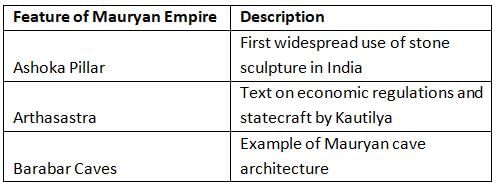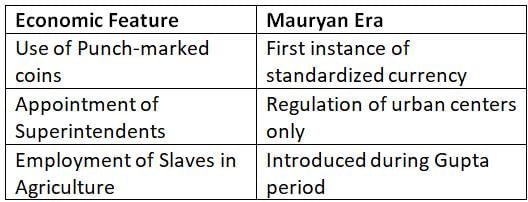Old NCERT Test (RS Sharma): Significance of the Mauryan Empire - UPSC MCQ
15 Questions MCQ Test - Old NCERT Test (RS Sharma): Significance of the Mauryan Empire
Consider the following pairs:

How many of the above pairs are correctly matched?

How many of the above pairs are correctly matched?
Consider the following statements:
- The Mauryan Empire introduced widespread stone masonry and remarkable art and architecture, including the Ashoka Pillar.
- Kautilya's Arthasastra suggests the use of slaves in large-scale agricultural operations began during the Maurya era.
- The Maurya Empire's downfall was accelerated by the Brahmanical reaction to Asoka's policies favoring Buddhism.
How many of the statements given above are correct?
Consider the following statements:
- The Mauryan administrative system was characterized by a vast bureaucracy with significant disparities in payment among officers.
- The appointment of 27 superintendents to regulate economic activities marks the beginning of state control over the economy in ancient India.
- Spies played a crucial role in the Mauryan era, especially in financial matters and intelligence gathering.
How many of the statements given above are correct?
Consider the following pairs:

How many of the above pairs are correctly matched?
Consider the following statements:
- The Mauryan Empire's extensive road network facilitated the movement of armies and the promotion of trade and communication.
- The spread of new material knowledge and the use of iron tools beyond the Gangetic heartland coincided with the rise of rival kingdoms, contributing to the Maurya Empire's decline.
- Asoka implemented a policy of acculturation, aiming to integrate tribal peoples into settled, taxpaying societies.
How many of the statements given above are correct?
Consider the following pairs:

How many of the above pairs are correctly matched?
Consider the following statements:
- Statement I: The Mauryan Empire's decline was partially due to the financial crisis stemming from excessive military expenditures and Asoka's generous donations to Buddhist monastics.
- Statement II: Asoka's policy of dhamma and his patronage towards Buddhism did not significantly impact the economic stability of the Mauryan Empire.
Which one of the following is correct in respect of the above statements?
Consider the following statements:
- Statement I: The Maurya Empire's administrative system included a hierarchical bureaucracy with the highest-ranking officials receiving payments as much as 48 thousand panas.
- Statement II: The administrative efficiency of the Maurya Empire was compromised due to the disparities in payment among officials, leading to widespread corruption and inefficiency.
Which one of the following is correct in respect of the above statements?
Consider the following statements:
- Statement I: The Mauryan Empire's economy was significantly advanced by the appointment of 27 superintendents to regulate various sectors, including agriculture, trade, and mining.
- Statement II: The economic regulations under the Maurya administration hindered the growth of private enterprise and led to the empire's economic stagnation.
Which one of the following is correct in respect of the above statements?
What pivotal role did espionage play during the Mauryan Empire?
Consider the following statements regarding the Maurya Empire:
1. The Mauryan state maintained an elaborate system of espionage to collect intelligence about foreign enemies and monitor the activities of officers.
2. The employment of slaves in agricultural operations was a common practice in India from Vedic times.
3. The term "tithas" refers to religious practices prevalent during the Maurya period.
Which of the statements given above is/are correct?
During the Maurya period in ancient India, which aspect facilitated transportation and promoted trade and communication?
Consider the following statements regarding the Mauryan Empire:
1. The Maurya rulers did not have to manage a large population, as the army size did not exceed 650,000 men.
2. The Mauryas introduced widespread use of stone masonry and built impressive structures like the Maurya palace at Pataliputra.
3. The Maurya period saw the use of iron tools like socketed axes, sickles, and ploughshares spreading beyond the Gangetic basin.
Which of the statements given above is/are correct?
How did the spread of material culture influence regions like Andhra and Karnataka according to the provided content?
Consider the following statements:
1. Elements of middle Gangetic material culture were transferred with modifications to northern Bengal, Kalinga, Andhra, and Karnataka.
2. The spread of steel technology may have occurred through Maurya contacts, leading to the use of better cultivation methods in Kalinga.
3. The Satavahana empire in the Deccan projected some administrative units of the Mauryas, and Buddhism flourished similar to the Mauryan era.
Which of the statements given above is/are correct?














